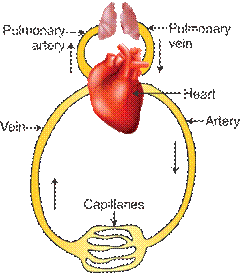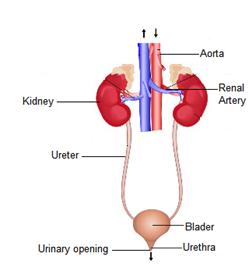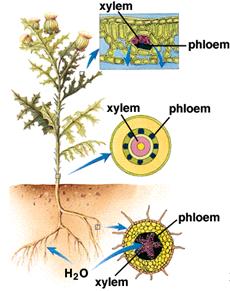We have learnt earlier that all organisms need food, water and oxygen for survival. They need to transport all these to various parts of their body.
Blood
Blood is the fluid which flows in blood vessels. It transports substances like digested food from the small intestine to the other parts of the body. It carries oxygen from the lungs to the cells of the body. It also transports waste for removal from the body.

There are basically two types of blood cells. One type of cells is the red blood cells (RBC) which contain a red pigment called haemoglobin.
The blood also has white blood cells (WBC) which fight against germs that may enter our body.
The clot is formed because of the presence of another type of cells in the blood, called platelets.
Blood vessels
There are different types of blood vessels in the body. We know that during inhalation a fresh supply of oxygen fills the lungs. Oxygen has to be transported to the rest of the body.
There are two types of blood vessels, arteries and veins are present in the body. Arteries carry oxygen-rich blood from the heart to all parts of the body. The number of beats per minute is called the pulse rate. A resting person, usually has a pulse rate between 72 and 80 beats per minute.
Veins are the vessels which carry carbon dioxide-rich blood from all parts of the body back to the heart. The veins have thin walls.

The tissues, they divide further into extremely thin tubes called capillaries. The capillaries join to form veins which empty into the heart.
Heart
The heart is an organ which beats continuously to act as a pump for the transport of blood, which carries other substances with it.
The heart is located in the chest cavity with its lower tip slightly tilted towards the left.

The two upper chambers are called the atria (singular: atrium) and the two lower chambers are called the ventricles.
Heart beat
The walls of the chambers of the heart are made up of muscles. These muscles contract and relax rhythmically. The rhythmic contraction followed by its relaxation constitute a heartbeat.
The doctor feels your heartbeats with the help of an instrument called a stethoscope. A doctor uses the stethoscope as a device to amplify the sound of the heart.
When our cells perform their functions, certain waste products are released. These are toxic and hence need to be removed from the body. The process of removal of wastes produced in the cells of the living organisms is called excretion. The parts involved in excretion form the excretory system.
Excretory system in humans
A mechanism to filter the blood is required. It's done by the blood capillaries in the kidneys.
When the blood reaches the two kidneys, it contains both useful and harmful substances. The useful substances are absorbed back into the blood. The wastes dissolved in water are removed as urine. From the kidneys, the urine goes into the urinary bladder through tube-like ureters. It is stored in the bladder and is passed out through the urinary opening at the end of a muscular tube called urethra.

An adult human being normally passes about 1−1.8 L of urine in 24 hours. The urine consists of 95% water, 2.5% urea and 2.5% other waste products.
The plants take water and mineral nutrients from the soil through the roots and transport it to the leaves. The leaves prepare food for the plant, using water and carbon dioxide during photosynthesis.
Plants absorb water and minerals by the roots. The roots have root hair. The root hair increase the surface area of the root for the absorption of water and mineral nutrients dissolved in water. The root hair is in contact with the water present between the soil particles.

The vessels are made of special cells, forming the vascular tissue. A tissue is a group of cells that perform specialised function in an organism. The vascular tissue for the transport of water and nutrients in the plant is called the xylem.
Plants absorb mineral nutrients and water from the soil. Not all the water absorbed is utilised by the plant. The water evaporates through the stomata present on the surface of the leaves by the process of transpiration.
